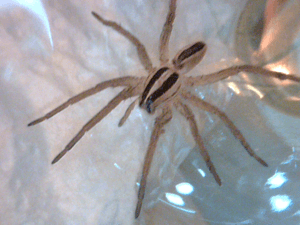Dotted wolf spider facts for kids
Quick facts for kids Dotted wolf spider |
|
|---|---|
 |
|
| Female Rabidosa punctulata collected at 36° N 80° W. Body length was 17 mm. She was quite calm about being moved into various poses by finger and gave no sign of aggression | |
| Scientific classification |
The dotted wolf spider (scientific name: Rabidosa punctulata) is a cool spider that belongs to the wolf spider family, also known as Lycosidae. These spiders are often found in grassy areas and fields. Unlike many spiders, they don't build webs to catch their food. Instead, they are active hunters who chase down their prey!
Contents
Discover the Dotted Wolf Spider
Dotted wolf spiders are interesting creatures that play a role in their environment. They are known for their unique hunting style and their ability to blend in with their surroundings.
What Does a Dotted Wolf Spider Look Like?
The dotted wolf spider is a medium to large-sized spider. It usually has a light brown body. You can often see stripes on its cephalothorax. This is the front part of its body where its head and legs are.
Identifying Features
Its abdomen, which is the back part of its body, has light spots. It also has a dark stripe running down the middle. These markings help it hide in tall grasses and weeds. Adult females can grow to about 17 to 19 millimeters long.
Where Do Dotted Wolf Spiders Live?
You can find dotted wolf spiders in many parts of North America. They prefer places with lots of plants. This includes areas with weeds and tall grasses.
Spider Habitats
Their range stretches from Massachusetts in the east. It goes west all the way to Kansas. Southward, you can find them in Texas and Northern Florida. They are quite common in these areas.
How Do Wolf Spiders Hunt?
Wolf spiders are named for their hunting style. They don't spin sticky webs to catch insects. Instead, they actively stalk and pounce on their prey.
Spider Senses
They have excellent eyesight, which helps them spot their prey. They also have strong legs that allow them to run quickly. This makes them very effective hunters in their grassy homes. They usually hunt at night, but you might see them during the day too.


